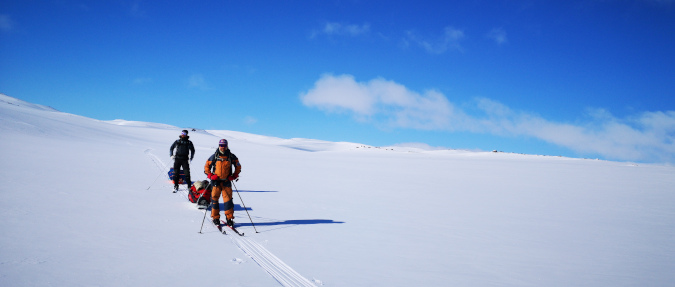
As most Norwegian anglers begin their summer season, a few of us seek out the magnificent opportunities for brown trout ice fishing in the mountains.
The calendar said May 1, but there was nothing to remind us of spring as we ascended onto the mountain plateau. It was snowing heavily, and at Haugastol village we had to wait for the plow truck to clear the road before continuing. We had been driving all night when we finally reached the Dyranut tourist cabin by the main road crossing the plateau connecting east to west. This was our starting point, going south deep into Hardangervidda national park.
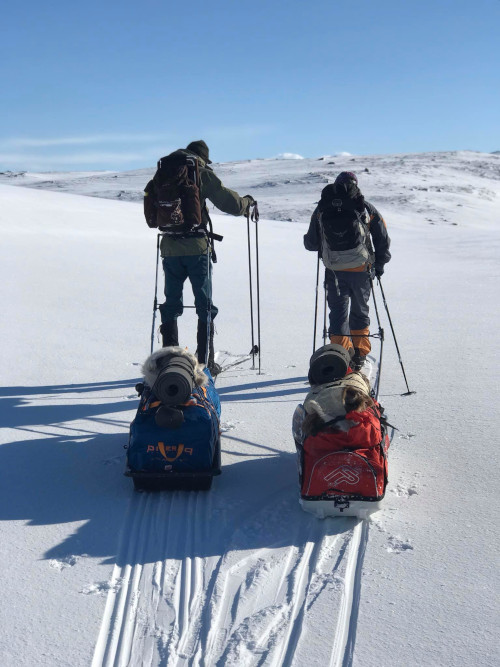
Early May is a treacherous time in these mountains. You can have blizzards and balmy sunshine within minutes of each other, and one needs to be prepared for both. Luckily, the snowstorm gave way to calmer weather as we started to pull our sleds southwards at dawn. Eight inches of fresh snow made pulling the gear exceptionally hard. The snow was sticking to our skis, making it hard to glide forward. It felt more like snowshoeing than skiing. Just like the Imperial walkers from the Star Wars movies, we had to lift our feet off the snow for every step. The reason that comparison came to mind is that the scenes depicting the ice world of Hoth in the second original Star Wars were shot in these mountains around forty years ago.
As daylight revealed the surrounding mountains, it was clear that winter was still holding on strong. The snowmelt had hardly begun, and last night’s snowfall would postpone the onset of spring even more. Progress was slow, and we knew it would take all day to reach the designated lake some 20 miles into the mountains. The last leg of the trek also entails a time-consuming climb into even higher elevations. It was just about nightfall when we finally arrived at the lake 4600 feet above sea level. Even though our crew consisted of men no strangers to the trials of mountaineering, we all felt exhausted. Falling asleep in the tent was never easier.
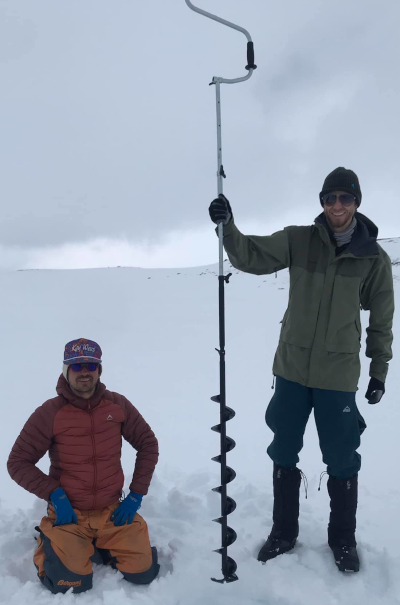
Spanning 3320 square miles in the mountainous central part of south Norway, Hardangervidda is among the largest national parks in the Nordic region. The area is littered with lakes, and there is a proud and prevalent trout fishing tradition. Archeological findings have indicated that trout were already present here 4000 years ago and that humans probably aided its spread. After the end of the last ice age, the fish that started to populate the emerging river and lake systems would eventually face natural obstacles. Evidence suggests that people were responsible for moving different species of fish into otherwise inaccessible areas. Imagining prehistoric hunter-gatherers, carrying trout from one lake to the next in these remote mountains is awe-inspiring. Here we are thousands of years later, ready to reap the fruits of their labor.
Early next morning, we awoke to ideal ice fishing conditions. A gentle breeze and mostly clear skies are more than you can hope for at this time of year. It had been a long winter with lots of snow and varying temperatures. We knew that the ice would be thick and layered. Lakes in the south of Norway at this elevation are usually only ice-free from mid-June to late October, so there is plenty of time for the ice to build. When working our way through, we started to doubt if the ice auger was even long enough. Having connected two separate extensions, and the internal extension pulled out, we had the longest ice auger I had ever seen. Drilling down by hand was hard work, but eventually, we broke through. The ice measured 7 feet 5 inches, matching the length of the ice auger exactly. One inch thicker, and we would not have been able to fish.
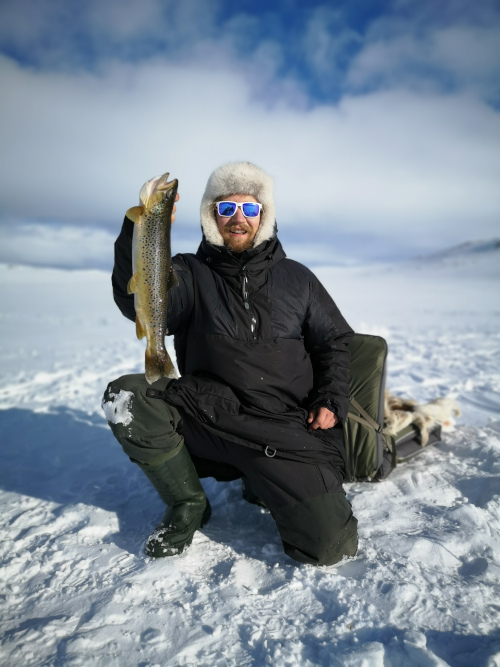
A couple of years prior, I had successfully fished this lake, and knew that it held decent size fish. We started drilling a few holes around about the same area where I had caught them before. Last time, all the fish were caught near the bottom, between depths of 20 to 30 feet. I assumed we would find them in roughly the same spot. The trout do not seem to move around much underneath the thick ice cover. It probably needs to conserve as much energy as possible during the long winter months. Stationary fish means that it is the fisherman’s job to locate it. Sometimes only a few yards separate success from failure. This time we struck gold right away.
I had just lowered the first simple tackle using only a split-shot and a worm-baited hook when the first fish went for it. Sometimes it can be that easy. These mountain trout are tough as nails and offer good fights on small ice rods. The fish were in the right mood this first morning, and we all caught several nice trout within the first few hours. We were using all kinds of tackle, and the fish was not very picky. Natural baits like worms and maggots caught the most fish, but small balance lures also did the trick. Later in the day, it went quiet, and bites were few and far between. In my experience, that is usually what happens in these mountain lakes. It seems the fish are feeding at certain periods during the day, and not more than an hour or two at a time. It was in the early morning and late afternoon that the fish were biting, and very few were caught during the day.
The trout in this lake are exceptionally good to eat. That is part of the reason it is so rewarding to make the arduous trip. If one is as lucky as we were, there is an opportunity to bring back several pounds of trout for the freezer. The quality of the fish is truly amazing. Of course, one should be mindful not to harvest too much from certain lakes, but this remote area is rarely visited (motorized transportation is prohibited). Arguably, it is very beneficial to harvest such lakes sustainably to ensure a healthy population. There are many examples of overpopulated lakes across Hardangervidda national park where the trout are small and of poor quality. The fish here has very few natural predators and can multiply very quickly given the right circumstances.
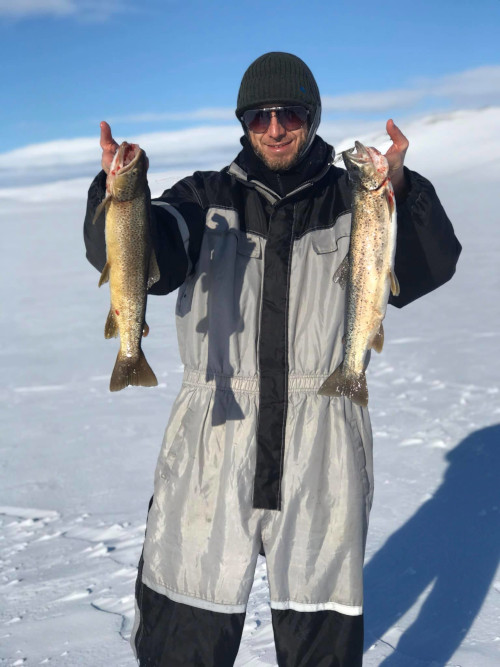 This particular lake has a very healthy population of good size fish. We caught more than 30 trout with sizes ranging from 1 to 3 lb over the course of two days, which is quite an exceptional catch in these parts. Burying the fish in snow during the night left them frozen solid. We would have brought them all back to our own freezers had it not been for the visitor that came in the middle of the final night. Tracks in the snow revealed what was most likely a cunning Arctic fox that had found our stash and preceded to run off with half of it during the night. Maybe it was a sign from mother nature that we had been a bit too greedy. I hope there was a family of foxes nearby that benefitted from the extra calories at the end of a long winter.
This particular lake has a very healthy population of good size fish. We caught more than 30 trout with sizes ranging from 1 to 3 lb over the course of two days, which is quite an exceptional catch in these parts. Burying the fish in snow during the night left them frozen solid. We would have brought them all back to our own freezers had it not been for the visitor that came in the middle of the final night. Tracks in the snow revealed what was most likely a cunning Arctic fox that had found our stash and preceded to run off with half of it during the night. Maybe it was a sign from mother nature that we had been a bit too greedy. I hope there was a family of foxes nearby that benefitted from the extra calories at the end of a long winter.
Hauling our sleds back to civilization the next day was much easier than going in. The snow was firm again, and the sun was shining bright. Enjoying spectacular views over these vast mountains makes the long trek all worthwhile. Exceptional trout fishing is only the icing on the cake. After several hours, we arrived back at the car. Tired. Sunburned. Yet strangely energized. That is what trips like this and the connection to nature does to you. It fatigues your body but revitalizes your soul.
Lars Eriksen
004793230951
I am a Norwegian angler and freelance writer. I write about fly fishing, ice fishing and other nature related subjects. I publish articles in different online publications and paperback magazines.
